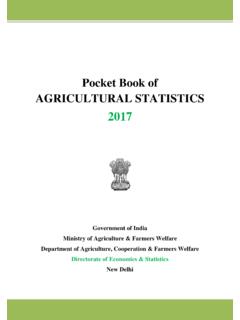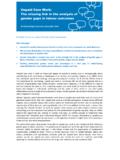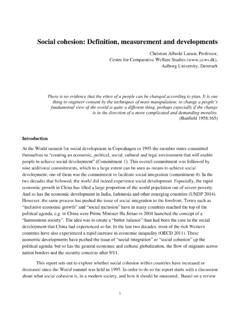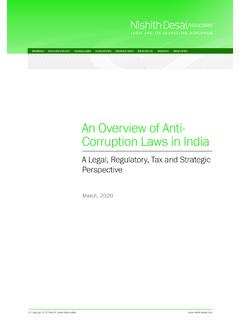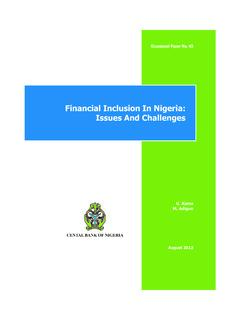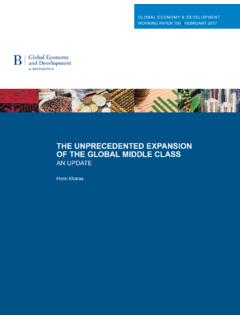Transcription of A Survey Report on Foreign Direct Investment in Nepal - NRB
1 A Survey Report on Foreign Direct Investment in Nepal Nepal Rastra Bank Research Department June 2018 A Survey Report on Foreign Direct Investment in Nepal Nepal Rastra Bank Research Department Foreword Foreign Direct Investment (FDI) serves as a catalyst for development in an open integrated economic system. Since 1980s, cross border linkages through FDI have been an important feature of financial globalization and liberalization process. Nepal has also introduced many provisions to attract FDI including a set of legal, regulatory and institutional framework. Though FDI inflow in Nepal is low compared to its neighboring countries, it has been on an increasing trend over the recent past.
2 Foreign investors from 39 countries have made Investment in 252 firms in Nepal . The FDI stock reached Rs. billion ( percent of GDP) in 2015/16, which was mainly driven by the rise in reserves of FDI-based industries. Reserve constitutes two-third of FDI stock. The services sector accounts for the highest share ( percent) of outstanding FDI in Nepal . In terms of paid up capital, the highest FDI in Nepal is from india . When total stock of FDI is taken into consideration by including reserves and loans, West Indies happens to be the major source region with FDI of Rs. billion as of mid-July 2016. Nepal Rastra Bank completed this Survey with the valuable support from various institutions and individuals.
3 I would like to extend my sincere gratitude to government institutions, FDI firms and stakeholders for their assistance with the information collection of this Survey Report . At this moment, I would like to acknowledge the contribution of all colleagues of Balance of Payments and International Finance Division of Research Department for the successful completion of this Survey . As such, thanks are due to Deputy Directors Mr. Suman Neupane and Mrs. Ranjana Pandit, and Assistant Directors Mr. Rabindra Maharjhan, Mrs. Jayanti Chapagain, Mr. Min Prasad Pokhrel, Mr. Khageswor Bhandari, Mr. Rajiv Sharma Regmi, Mr. Mitra Prasad Timsina, Mr. Arjun Subedi and Mr. Bharat Owd. I would also like to thank Executive Director Mr.
4 Pitambhar Bhandari, Directors Mr. Pradeep Raj Poudyal, Dr. Gunakar Bhatta, Dr. Prakash Kumar Shrestha and Dr. Dilli Ram Pokhrel for their support in finalizing this Survey Report . Nepal Rastra Bank has been conducting annual FDI Survey regularly since long ago. However, it is the first time that a comprehensive Survey of this kind has been made available to the public. I believe that the findings of this Survey will be useful in bridging the information gap for the formulation of FDI programs and policies. June 2018 Nara Bahadur Thapa Executive Director Research Department TABLE OF CONTENTS EXECUTIVE SUMMARY I ABBREVIATIONS IV 1. INTRODUCTION 1 Background 1 Objectives of the Study 2 Significance of the Study 3 Survey Methodology 3 Study Area 4 Population and Sample 4 Survey Method 5 FDI Compilation Method 7 Limitations of the Study 7 Structure of the Report 8 2.
5 REGULATORY FRAMEWORK 9 FDI Policy in Nepal 9 Legal Framework 11 Institutional Structure 11 FDI Process in Nepal 12 General Regulatory Arrangement For FDI 13 Taxation 13 Foreign Exchange Arrangement 13 Labor Regulation 14 Land Regulation 14 Intellectual Property Law 15 Administrative issues 15 Priority Sectors 15 Key Sectors 15 3. Foreign Direct Investment IN Nepal 18 FDI in Nepal 18 International Investment Position of Nepal 19 Dividend Repatriation 20 4. Foreign Direct Investment IN Nepal : Survey RESULTS 21 The Stock of FDI in Nepal 21 FDI Outstanding by Sectors 22 FDI Outstanding by Country 24 Foreign Loan 26 FDI in Manufacturing Sector 26 5. CONCLUSIONS 29 References 30 Appendix I Foreign Investment 32 Appendix II The Stock of FDI by Sectors 33 Appendix III The Stock of FDI by Countries 34 Appendix IV The Stock of FDI by Countries and Sectors 35 1.
6 I Executive Summary 1. Nepal Rastra Bank (NRB) conducted this Survey with an objective of identifying the position of Foreign Direct Investment (FDI) in Nepal in 2015/16. This Survey has identified the country-wise and sector-wise stock of FDI. The Survey Report incorporates the information on reserves, reinvested earnings and loans which are used to prepare International Investment Position (IIP) of Nepal . This information is also expected to fill the information gap on the status of FDI industries as well as strengthen the FDI programs, policies and regulatory framework. Methodology 2. The FDI Survey is one of the regular surveys conducted annually by the NRB to record Foreign Investment in Nepalese industries.
7 The strategy of the Survey is to make the FDI statistics highly comprehensive in terms of coverage of the enterprises. The FDI enterprises are categorized into three groups, large, medium and small based on capital. Out of 252 firms (population of Survey ), 29 firms are from large group whereas 40 firms from medium group and 183 firms are from small group. In terms of equity capital, these three groups constitute 85 percent, percent and percent respectively. The census method is applied to large 29 firms (100 percent) while the sample method is applied to select 24 firms out of 40 firms (60 percent) from medium group and 73 firms out of 183 firms ( percent) from small group.
8 The selected firms capital (Rs. billion) is percent of total (Rs. billion). FDI inflows in Nepal 3. The FDI inflows in Nepal is substantially low compared to neighboring countries. It shares only percent of total FDI in the world while the South Asia received percent of total FDI inflows in 2016. 4. The statistics on approved and actual FDI shows small amount of FDI prior to 2007/08. Thereafter, it accelerated along with the initiation of the peace process in the country. IIP of Nepal 5. The net IIP, which is the difference of Foreign assets and liabilities, was Rs. billion in mid-July 2017 compared to Rs. billion in mid-July 2016, and Rs. II billion in mid-July 2015.
9 IIP also shows the stock of FDI which recorded Rs. billion FDI as in mid-July 2013, gradually increased to Rs. billion as in mid-July 2017. Dividends Repatriation 6. The dividend repatriation by FDI firms, based on approval from NRB, amounted to Rs. billion in 2016/17 compared to Rs. billion in 2015/16 and Rs. billion in 2014/15. Outstanding FDI in Nepal 7. The FDI stock includes the sum of paid-up capital, reserves and loans of FDI enterprises in Nepal . The stock of FDI in Nepal reached Rs. billion ( percent of the GDP) as in mid-July 2016, registering a growth of percent over the previous fiscal year. 8. The share of reserve capital in FDI remained the highest ( percent) followed by the paid-up capital with percent share and outstanding loans with percent share.
10 9. The service sector received the major share of FDI followed by the industry and the agricultural sector. About percent (Rs. billion) of total stock of FDI is in the service sector, percent (Rs. billion) in the industry and the remaining percent (Rs. 395 million) in the agriculture sector. 10. Under the service sector, transport, storage and communication received the dominant share of percent. Manufacturing industries, and electricity, gas and water are main sub-sectors receiving FDI in the industry sector percent and percent respectively. 11. Foreign investors from 39 countries have made Investment in 252 firms in Nepal . india is the main investor in Nepal in terms of paid up capital.
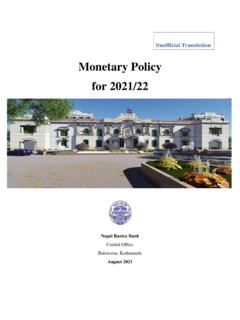





![PsLs[t lgb]{zg, @)&*](/cache/preview/c/9/4/8/1/7/3/6/thumb-c9481736ff2a35d3e2563fbfd6c09f64.jpg)
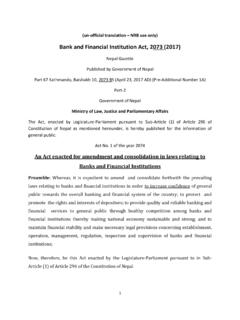
![cfly{s jif{ @)&*÷&( sf] df}lb|s gLltsf] klxnf] q}dfl;s ;dLIff](/cache/preview/1/1/1/9/d/2/5/5/thumb-1119d255f839d189d645cf52a0f2f356.jpg)

